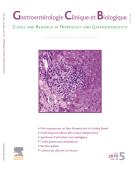Management and predictors of early mortality in elderly patients with iron deficiency anemia: a prospective study of 111 patients - 26/03/08
Stéphane Nahon [1],
Pierre Lahmek [1 et 2],
Nazmye ARAS [1],
Cécile Poupardin [1],
Bruno Lesgourgues [1 et 2],
Gilles Macaigne [3],
Nicolas Delas [1]
Mostrare le affiliazioniPrise en charge et facteurs prédictifs de mortalité chez les malades âgés avec anémie ferriprive: étude prospective de 111 patients |
Objectifs |
L'anémie ferriprive (AF) chez la personne âgée résulte essentiellement d'un saignement digestif nécessitant une exploration endoscopique. Le but de cette étude prospective a été d'évaluer dans cette population: 1) la faisabilité de l'endoscopie, 2) l'impact thérapeutique (recours à un traitement), et 3) d'identifier des facteurs prédictifs de mortalité à court terme.
Malades et Méthodes |
De juin 2003 à mai 2005, tous les malades âgés de plus de 75 ans hospitalisés et ayant une AF ont été inclus. Les données cliniques (notamment les comorbidités), biologiques, endoscopiques et thérapeutiques ont été collectées. Un suivi un mois après l'endoscopie ou après traitement a été réalisé afin d'en apprécier la morbidité et la mortalité.
Résultats |
Cent onze malades (69 femmes, 82,3 ± 6,4 ans) avaient une AF, 102 (92 %) ont eu une endoscopie haute et 91 (82 %) une coloscopie. Neuf (8 %) n'ont eu aucune exploration en raison d'un mauvais état général (N = 4) ou d'une démence (N = 5). Soixante-quatre malades avaient au moins deux comorbidités significatives. Une cause de saignement a été identifiée chez 75 (68 %) malades dont 12 (11 %) avaient une lésion synchrone, 43 (39 %) une cause colique dont 31 (72 %) cancers colorectaux, et 44 (40 %) une cause digestive haute. Soixante-neuf (92 %) des 75 malades ont reçu au moins un des traitements suivants: médical (N = 27), endoscopique (N = 20), et chirurgical (N = 31). La chirurgie était curative dans 28/31 (90 %) cas. À un mois, la mortalité globale était de 11/111 (10 %) et de 4/31 (13 %) après chirurgie. Les facteurs prédictifs de mortalité étaient (Odd ratio, Intervalle de Confiance à 95 %): une cause maligne (42; 3-588), l'absence de traitement (34; 3-423), et la présence d'au moins 2 comorbidités significatives (20; 1-400).
Conclusion |
Dans une population non sélectionnée de personnes âgées hospitalisées et ayant une AF, une exploration endoscopique est généralement réalisable, permettant d'identifier fréquemment une cause, notamment un cancer du côlon. Un traitement curateur notamment chirurgical est possible sans augmentation de la mortalité à court terme.
Objectives |
Iron deficiency anemia (IDA) is common in the elderly. It usually results from gastrointestinal (GI) bleeding and requires endoscopic exploration of the gastrointestinal tract. The aim of this prospective study in elderly patients was to evaluate the feasibility of endoscopy, the therapeutic impact, and identify predictors of early mortality.
Methods |
From June 2003 to May 2005, all patients over 75 years, hospitalized for anemia were screened for iron deficiency. Clinical (including serious comorbidities), biological, endoscopic and therapeutic data were collected. One month after treatment, a follow-up was carried out to assess the tolerance of such investigation and treatment.
Results |
One hundred and eleven patients (69 women, 82.3 ± 6.4 years) had IDA, 102 (92%) underwent an upper endoscopy and 91 (82%) a colonoscopy. Nine (8%) patients were not investigated because of poor clinical condition (N=4) or dementia (N=5). Of the 75 (68%) patients with an identified source of bleeding, 12 (11%) had a synchronous lesion, 43 (39%) a colorectal source including 31 (72%) colorectal cancer, and 44 (40%) an upper GI source. Sixty-nine (92%) of the 75 patients received at least one of the following treatments: medical (N=27), endoscopic (N=20), and surgical (N=31). Surgery was curative in 28/31 (90%) cases of which 25/27 were colorectal cancers. One month after treatment, overall mortality was 11/111 (10%) and 4/31 (13%) after surgery. Predictors of early mortality (Odd ratio, 95% Confidence Interval) were: a malign cause (42; 3-588), no specific treatment (34; 3-423), at least 2 co-morbidities (20; 1-400).
Conclusion |
In an unselected hospitalized population of elderly patients with IDA, endoscopy was generally feasible, allowing identification of a source of bleeding, especially colorectal cancer. A specific treatment was usually possible and proved curative without increase in early mortality.
Mappa
© 2007 Elsevier Masson SAS. Tous droits réservés.
Vol 31 - N° 2
P. 169-174 - Febbraio 2007 Ritorno al numeroBenvenuto su EM|consulte, il riferimento dei professionisti della salute.

